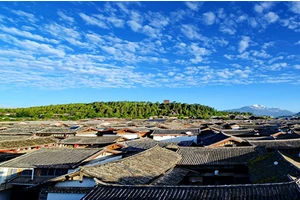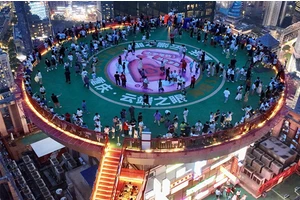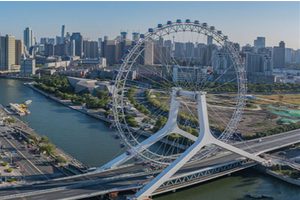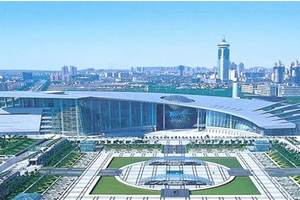Fujian Pucheng Tourism
Fujian Pucheng tourist attractions:
1. Nanping Impression Xiaomi China Baojiu Culture Expo Park is a national AAAA-level tourist attraction.
The Expo Park presents China traditional culture, Pucheng characteristic culture and Xiaomibao wine culture in the style of "Huizhou School Construction+Suzhou Garden", which integrates production, sightseeing, accommodation, catering, culture and shopping, promotes tourism with industry, and promotes the development mode of industry with tourism to create a "five good" tourist attraction that is good-looking, fun, delicious, delicious and well-lived.
2. Jiling Green Paradise
Jiling Village is located in the east of Shuibei Street Town, Pucheng County. Its leading industries are bamboo, rice, flue-cured tobacco and eco-tourism. It has successively won the titles of "Fujian Eco-village", "Fujian Rural Tourism Characteristic Village", "Fujian Most Beautiful Leisure Village" and "Nanping Five-star beautiful countryside".
3. Pucheng Wulongshan Agricultural Sightseeing Park
Wulongshan Agricultural Sightseeing Park is located at the foot of Wulong Mountain in Xinqiao Village, with beautiful scenery. The forest coverage area in the park is nearly 10,000 mu, and the vegetation is good. The planned area is about 3,000 mu.
4, Pucheng Shili Liantang Scenic Area
Shili Liantang, one of the sub-projects of Pucheng County's "Watery and Beautiful City" construction, is located in liantang town, which connects the various landscape nodes in its jurisdiction, such as Gumanshan Bridge, Tianxia Wenzhang, Nanshan Mountain, Putian First Line, Wenxi Xiyan and Beautiful Tongyuan, into a line, which can be described as "one scene at a time".
5. Fugai Mountain
The total area is about 10 square kilometers, the main peak is 1146.4 meters above sea level, and there is a 30-kilometer highway around the mountain at the foot of the mountain, which can be used by large and small vehicles. It is like a dragon with its tail in the northwest and its head in the southeast, which is located on the border of Fujian, Zhejiang and Jiangxi provinces.
1. Introduction of tourist attractions in Pucheng County, Fujian Province
The overall terrain of Gengdu Village is high in the west and low in the east. Dashi Mountain, which rises abruptly from the back to the west and stretches for more than 1000 meters, is adjacent to Hutang Reservoir and Xiaokeng Reservoir with a sparkling water surface of 100,000 square meters in the east, and is located on National Highway 205, 2 kilometers east of Gengdu Village surrounded by five lush hills, which can communicate with other counties (cities) and provinces such as Changshan County and Pucheng County (Fujian Province) quickly. There is a river (Jiangshan)-bridge highway in the north of the village, which passes through the river village and Hutangling in the north of the village; Plough (ploughing) and Yan (sliding) highways run through the village, connecting some towns and villages in Jiangshan City, Yushan and Guangfeng County, Jiangxi Province, as well as towns and villages such as Tan Shi, Daqiao, Xintangbian and Yuyu in Jiangshan. Hangzhou under construction can often cross villages. Jiangshan is only half an hour away. We drive from the farm to study.
2. Tourist attractions in Pucheng County, Fujian Province
The interesting scenic spots in Shangrao, Jiangxi are:
Castle Peak Scenic Area:
Castle Peak is located at the junction of Dexing City and Yushan County. It is the first world geological heritage in Jiangxi Province, the National Geopark, and the python in it is known as the uncanny workmanship of nature. Many foreign tourists are attracted to visit every year.
Yang Guifeng Scenic Area:
Guifeng is a national AAAAA scenic spot, located in the southwest of Yiyang County, Jiangxi Province. There are three wonders in Guifeng Scenic Area: the first, there are Chinese Danxia boutique and Oriental turtle paradise;
Secondly, the scenic spots are unique caves and niches, with clear water and numerous grottoes, such as Nanyan, Shuangyan Zen Ancient Temple and Feiyousi Longmen Rock, the largest Buddha cave in China; The three scenes are the wonders of people with lofty ideals, which have been passed down through the ages. Dieshan Academy embodies Xie Dieshan's patriotism and the loyal soul of Tieji, and Fang Zhimin Memorial Hall shows the incomparable glory and pride of Red Land.
Wuyuan, the most beautiful village in China;
Wuyuan county, as a global tourist area, is the leading S-tourism in Shangrao, and its tourism reputation is even greater than Shangrao, so that many people have heard of Wuyuan but not Shangrao. Since the Hefei high-speed railway was opened to traffic,
The transportation to Wuyuan is much more convenient, which brings more tourists to Wuyuan at once. Wuyuan's rape blossoms, folk customs and large-scale landscape performances can give people an unparalleled happiness. t like this city.
Shangrao Lingshan scenic spot
Lingshan, located in Shangrao County, is a national AAAA scenic spot. It is listed as the 33rd blessed Taoist book in the world. Because the mountains are rolling, like a Jiangnan beauty sleeping beside her, she is praised as a sleeping beauty by the world.
Lingshan, the nearest scenic spot to Shangrao, is being vigorously developed, including Lingshan Zen Cultural and Creative Park and other projects. The flowers at the foot of Lingshan Mountain are also favored by tourists.
Poyang Lake National Wetland Park
Located in Poyang County, Shangrao City, Jiangxi Province, and on the east bank of Poyang Lake, the park is one of the six largest wetlands in the world, a national wetland park with the largest wetland area and the richest wetland species in Asia, a national 4A-level scenic spot and a popular science education base in China. Also known as a paradise for waiting for birds.
Ten thousand Shennong yuan:
Wannian Shennong Garden Scenic Area consists of Shennong Palace Scenic Area and Xianren Cave Scenic Area. It is a national AAAA scenic spot.
Shennonggong Scenic Area is dominated by karst underground caves and underground rivers, especially the Shennong River, which is 460 meters long, and is known as the most beautiful underground river in China because of its beautiful mountains and peaks.
Guangfeng:
Tongboshan is located in the south of Guangfeng District, Shangrao City, Jiangxi Province, and belongs to the northern foot of the eastern section of Wuyishan Mountain. The main peak is 38 kilometers away from the county seat, located at the junction of Guangfeng District, Pucheng County and Wuyishan City in Fujian Province, with an altitude of 1534.6 meters, which is the highest point in Guangfeng District.
Yanshan Hekou Ancient Town:
ancie
Damaoshan Scenic Area is located in the world copper capital of Dexing City, in the geographical center surrounded by Sanqingshan, Longhushan, Wuyuan and Jingdezhen. It is another peak of Huaiyu Mountain, with a planned area of 143 square kilometers. It was listed as a provincial-level scenic spot by the provincial people, and was rated as a national AAAA tourist attraction in December 2014.
Wufushan, Shangrao County
Wushan is located in the south of Shangrao County, Jiangxi Province (in Wufushan Town), facing Sanqing in the north and Wuyi in the south, at the northern foot of Wuyi Mountain. The main peak of Wushan is 1891.4 meters above sea level, which is the third peak in East China. Standing in Wu Fugang, you can see the surrounding provinces and cities, including Quzhou, Zhejiang. At present, Wufushan has been connected with the high-speed railway. Although it is the smallest Wufushan station in high-speed railway station, it can bring good opportunities for tourism development.
3. Fujian Pucheng Red Tourist Attractions
The scenic spots in Nanping City include the scenic Yi Mountain, Mangdang Mountain with natural oxygen bar, saionji, a good summer resort, Xiaowuyi with unique Danxia scenery, Heping Ancient Town, a Millennium ancient city, and Revolutionary Red Gold Pit. These are some scenic spots and places worth visiting in Nanping. These are the places I have been. You can visit them when you have time.
4. What are the scenic spots in Pucheng County?
Recently, the media voted for the top 10 most popular scenic spots in Weinan by netizens. The list is as follows:
First place: Huashan Scenic Area in huayin city.
Second place: Dangjia Village, an ancient village in Hancheng in Ming and Qing Dynasties.
Third place: Shaohua Mountain National Forest Park in Huazhou District.
Fourth place: Tongzhou Lake Scenic Area in Dali County
Fifth place: Weinan Luyang Lake Scenic Area
Sixth place: Fuping Taoyi Village Scenic Area
Seventh place: Yaotouyao Cultural Tourism Ecological Zone in Chengcheng County
Eighth place: Sima Qian Temple Scenic Area in Hancheng
9th place: Xiyue Temple Scenic Spot in huayin city.
Tenth place: Wang Ding Memorial Hall Scenic Spot in Pucheng County.
What do you think of the above rankings? Which scenic spot in Weinan do you think is the most worth visiting? Which scenic spot is the least interesting? Welcome to leave a message for discussion!
5. Pucheng County Scenic Area
Work order s tears, dried bamboo shoots, tung oil, lotus seeds, Alisma orientalis, raw lacquer, Maozhou melon seeds and Jindoushan russula are all quite famous. Pucheng American economy has always attached importance to agriculture, mainly producing rice, and has long been known as the granary in northern Fujian. In Song Dynasty, Pucheng agriculture was quite developed, with 520 dams, ranking second in the province. When you get corn at the age of one, your neighbors will help you get salty resources. Folk songs say Pucheng has a bumper harvest and Fuzhou has rice. Pucheng Redmi Beauty is very famous in the whole province. "Yifu" is a local product of Lin named Pucheng, which was created by Wang Shimao in the Ming Dynasty during the period of Min Bu Shu. Sang Ma covered with bamboo shoots and covered with tea. Lu Yao's Smoke Spectrum said that Pucheng tobacco was the best in Fujian in Qing Dynasty. During Xianfeng and Tongzhi years in Qing Dynasty, Magnolia officinalis was transported to Fuzhou and Guangdong for countless years. Coix seed, dried bamboo shoots, tung oil, lotus seeds, Alisma orientalis, raw lacquer, Maozhou melon seeds and Jindoushan russula are all famous. [12] In ancient Pucheng, there were four major economic industries: metallurgy, ceramic manufacturing, textile and paper making. In the Song Dynasty, the ceramic industry reached its peak, and Dakouyao porcelain was exported to Japan, Korea and the Philippines. Textile products in the Ming Dynasty, such as silk and silk, were comparable to those in Zhejiang and Henan respectively. The mining industry has developed vigorously, and 18 silver yards have been mined successively. The paper industry developed in Qing Dynasty, especially playing with paper.
6. Top Ten Tourist Attractions in Pucheng County, Nanping
The interesting places in Nanping are as follows:
1. Wuyishan Scenic Area
Wuyishan Scenic Area covers an area of about 70 square kilometers and is a typical Danxia landform. Perfect combination of mountains and rivers, organic integration of humanity and nature, enjoying the clear water, Dan Mountain, world cultural and natural heritage, and the first batch of 5A-level scenic spots in China. Many beautiful scenery, such as Qifeng, Xiushui, Yougu, Dangerous Valley, etc., have a long history and culture, and many cultural relics make people linger. The whole scenic spot is full of scenery.
Gate fare: 1-day tour to 140 yuan/person, 2-day tour to 150 yuan/person, and 3-day tour to 160 yuan/person. Quxi Bamboo Raft Tickets 130 yuan/person.
Sightseeing tickets for scenic spots: one-day trip to 70 yuan/person; Two-day tour to 85 yuan/person; Three-day trip to 95 yuan/person.
Reservation telephone number: 0599-5250679
Wuyishan Scenic Area is an AAAAA-level scenic spot.
2. China Wuyi Tea Expo Park
In order to remember the great achievements of our ancestors and deepen tourists' understanding of Wuyi tea, Wuyishan City has specially built a tea culture grand view garden-China Wuyi Camellia Expo Garden on the Jiuqu River at the southern end of this resort, striving to present a three-dimensional picture scroll and an epic image for tourists!
Tea Expo Park is generally divided into five parts: landscape park, underground square, landscape performance viewing area, tea Expo Hall and tourist service center. In this park with an area of about 78,000 square meters, Wuyi tea has a long history, magical legends and profound craftsmanship. In order to enrich the history of Wuyi tea, show the charm of rock paintings, and let everyone appreciate the profound cultural heritage and attractive rock bones and flowers of Wuyi tea through the narration of celebrities, the reproduction of historical pictures and the interactive performance of tea art!
The plane of Tea Soul Square is blade-shaped, and the edge is inlaid with crimson granite, which symbolizes three reds and seven greens. The screen in the shape of a tea tree is in front of the square-there is a big red robe with the famous ci writers Xuechuan and the three saints of Wuyi-Shennong, Peng Zu and Wuyijun-standing behind. On both sides of the ring are 14 celebrities who have had an indissoluble bond with Wuyi tea in the past dynasties: Lu Yu, Sun Qiao and Xu Yin in the Tang Dynasty; Fan Zhongyan, Su Shi, Zhu and Kuaile in Song Dynasty, Du Ben in Yuan Dynasty; Chen Duo and Shi Chaoquan in Ming Dynasty; Dong Tiangong in Qing Dynasty; Modern Lian Jue Nong and so on. In the center of the square, Jiuqu River meanders like a dragon and flows quietly. The stream is dotted with landscape stones symbolizing the 36 peaks of Wuyishan; On both sides of the ground, there are Confucianism, Buddhism and Taoism for thousands of years, landscape tea for thousands of years and Zhu s nine songs-singing engraving. All this reflects a pot of tea in Wuyi landscape.
Yan Shihua Park is divided into nine areas, including ancient memories, Han and Jin relics, the legend of the prosperous Tang Dynasty, the elegant demeanor of the Song Dynasty, the royal tea garden in the Yuan Dynasty, the scattered tea in the Ming Dynasty, the oolong tea in the Qing Dynasty, the tea research base in the Republic of China, and the new rise of contemporary Wuyi tea. Select historical figures, historical events, historical documents and poems and songs closely related to Wuyi tea culture, and focus on displaying Wuyi tea's long history, broad culture and profound craftsmanship through concentration, close-up and on-site display.
From the ancient memory to the remains of Han and Jin dynasties, it contains the ancient history of tea town; In the later period, Ganhou and wax tea told the story of the prosperous Tang Dynasty. Fighting tea and distributing tea show the elegance of the Song Dynasty; The terrace of Shoushan in the Royal Tea Garden recorded the splendor of the Yuan and Ming Dynasties. Oolong tea rose in the Qing Dynasty, and Dahongpao shone in modern times. A story of rock tea embodies the essence of Wuyi tea culture and stirs the charm of rock rhyme.
Dahongpao Square is a square with an area of about 5,000 square meters and can accommodate 3,000 people. The podium can seat 180 people. The 45-meter-long flowing water in the square is engraved with memorabilia of tea history, from which we can clearly see the development of tea culture in China. The word Dahongpao can be clearly seen from the plane that the ground is inlaid with red granite. The word rock bone and flower fragrance highlights the main characteristics of Wuyi tea represented by Dahongpao.
Wuyi tea was quietly introduced into the palace during the Han and Tang Dynasties, and was paid tribute as an important part of tea building in the Song Dynasty, and its reputation became increasingly obvious. The rulers of the Yuan Dynasty formally accepted it as tribute tea. Officials who produce tribute tea built a royal tea garden on the south bank of Siqu in Jiuqu River to make tribute tea. It is also equipped with a fairy mirror and a Shoushan platform, which helps to expand.
Wuyi Xiangjiang Mingyuan Tea Culture Sightseeing Park covers an area of 170 mu, with a total construction area of more than 60,000 square meters, including Wuyi Tea Culture Expo Hall, automatic tea finishing production line, Mingcong Garden, traditional hand-made tea workshop, Mingxiang Lake atrium waterscape, teahouse, Qu Yun Gallery, tea kiosk, bucket teahouse, teahouse and product exhibition hall. The tea garden in the park is lush with green trees, and the buildings with local characteristics and strong tea culture are patchwork, supplemented by flower galleries, winding paths, ponds and waterside pavilions. It embodies the desire of harmony between man and nature, the characteristics and unique charm of green plants, blue sky and clear water. It is a garden-style landscape in the south of the Yangtze River, integrating tea planting, automatic processing and production, testing, tea product display, research and development, and tea industry ecological culture.
Wuyi tea culture exhibition hall
Through the models, pictures, objects and words of famous tea and famous mountains, famous tea and health preservation, famous tea and lamps, famous tea and celebrities, famous tea and folk customs, the long and heavy history of Wuyi rock tea is displayed, which plays a role in educating, publicizing, popularizing and carrying forward Wuyi tea culture.
Oolong tea processing automatic production line
The automatic production line of oolong tea finishing is a set of production equipment specially customized by Wuyishan Xiangjiang Tea Co., Ltd. according to the production technology of oolong tea. It combines China traditional oolong tea production method with modern mechanical production technology, is designed according to national standards, is in line with international standards, and is made of fully enclosed stainless steel. Tea leaves don't fall to the ground during processing, which integrates electricity, energy saving, sanitation and environmental protection, and realizes the whole process of computer-controlled automatic production. Every product must undergo strict testing and meet the national hygiene standards and the relevant requirements of the Food Safety Law before leaving the factory. All work has only one goal: to make products that reassure consumers.
Mingcongyuan
According to the technical requirements of planting management of Chashan Mountain in Wuyishan, the stepped bonsai-style ecological famous cluster variety garden is a tea research and planting base, and it is also an experiential tea garden for tourists to watch, take photos, sketch and pick.
Exhibition of traditional tea-making skills
On-the-spot master of tea art professionally explained the basic knowledge of identification, picking and production of Wuyi rock tea, and showed the traditional handcrafting skills of Dahongpao, a national intangible cultural heritage. Visitors can participate in the interaction and experience the fun of making tea.
Hu Ming atrium waterscape
The clear spring water flowing down from the back hill forms a winding stream and is written into the atrium lake, symbolizing the long history of tea culture. The lake and the surrounding scenery complement each other, forming a reflection, and the reality and reality coexist, creating a charming natural scenery.
Qu Yunlang
The central corridor of the garden twists and turns, such as nine twists and turns, with different scenery and unique charm.
Zhan Ming Concert Hall
The tea table in the tea hall is about 10 meters in diameter, and there is a 10-meter-high tea stove and teapot in the middle of the table, which can accommodate hundreds of people to taste tea at the same time and enjoy the wonderful tea fighting performance. The teahouse on the second floor provides a quiet and high-end place for tourists to enjoy tea. Participants can also learn while watching, make sideline products and integrate into the world of tea tasting that appeals to both refined and popular tastes.
Product exhibition hall
Through continuous scientific and technological innovation and research and development, Xiangjiang has now developed many famous products on the basis of the original name cluster: pure Dahongpao, iron arhat in the Inner Ghost Cave, Cinnamon in Zhongguyan, Narcissus in Stair Rock, Que Tongue in water curtain cave, Baihuadong Baisuixiang, Qishan Sydney and so on. Haixi No.1 and Watermelon No.1 lead the first place trend, which has written a new chapter for the development history of Wuyi Rock Tea.
In 2015, Wuyi Xiangjiang Mingyuan won the first batch of sightseeing factories in Fujian Province.
In 2016, Wuyi Xiangjiang Mingyuan was rated as a national 4A-level tourist attraction.
Wuyi Xiangjiang Mingyuan is an AAAA-level scenic spot.
The delicious places in Nanping are as follows:
1. Meishanpo, Sanyuaner Road, this is the People's Liberation Army.
5. Expensive: Du Jing Seafood Restaurant (Yuping Qiaotou, seafood eaters, I don't think there are many) Jiangyuan Revolving Restaurant (28th floor of Golden Center, Revolving Restaurant, Cantonese cuisine).
6. Beef balls. There is a stall in front of Yonghui Supermarket on Meishan hillside, which specializes in making big beef balls. Smaller ones are also delicious.
7. Introduction video of tourist attractions in Pucheng County, Fujian Province
First correct it. Minnan is Pucheng, and Pucheng should be from Nanping, Fujian. Guanzhong, pucheng county is an ancient county town and a provincial-level historical and cultural city in Shaanxi Province. Its population and area can be called a big county in Shaanxi Province. Tourist attractions include Lin Zexu Memorial Hall, Wang Ding Memorial Hall, Yang Hucheng Memorial Hall, Confucian Temple, Qing Dynasty Examination Institute, South Temple Tangta, North Temple Songta, Beimu Library and so on. Outside the city, there are five tombs of Tang emperors, such as Bridge, Jing, Guang, Hui and Tai, which are built on the mountain and set each other off. Pucheng has a prosperous culture in history. Wang Ding, Jingwumu, Li Yizhi, Yang Hucheng and other sages were born here.
8. Introduction to tourist attractions in Pucheng County, Fujian Province
Fugai Mountain, also known as Gaixian Mountain, is the junction of Xianxialing and Wuyishan. Fushan is the boundary mountain between Fujian Province and Zhejiang Province, located in the south of 28 Du Town, Jiangshan City, Zhejiang Province, and east of Liudun Village, Panting Township, Pucheng County, Fujian Province. It's 9 kilometers away from the eighth capital of the year, panting. Both Fujian and Zhejiang can enter the mountains. Fushan Scenic Area covers a total area of 14.40 square kilometers, and the main peak is 1146.4 meters above sea level. In the scenic area, all kinds of stubborn rocks are scattered all over the place, which are tuff. At the top of the main peak, rocks pile up, and the lower one looks like a plate and the upper one looks like a cover, hence the name Fugai Mountain. Located in Jiangshan city, part of it is well developed and there are tourist trails.






